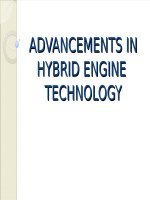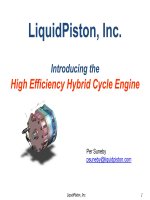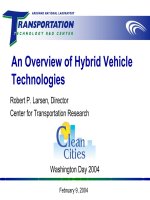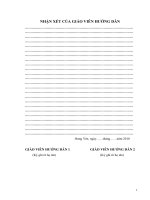Động cơ Hybrid - CACULATER
Bạn đang xem bản rút gọn của tài liệu. Xem và tải ngay bản đầy đủ của tài liệu tại đây (745.94 KB, 13 trang )
_____________________________________________________________________________________
www.stepcontrol.com Phone: (603) 882 1447 1
Stepper Motor System Basics (Rev. 5/2010)
Table of Contents
1.
STEPPER MOTOR SYSTEMS OVERVIEW .................................................... 2
2.
STEPPING MOTORS ...................................................................................... 3
TYPES OF STEPPER MOTORS ........................................................................................................... 3
VARIABLE RELUCTANCE ................................................................................................................................ 3
PERMANENT MAGNET .................................................................................................................................. 3
HYBRID .......................................................................................................................................................... 4
MOTOR WINDINGS ............................................................................................................................. 4
UNIFILAR ....................................................................................................................................................... 4
BIFILAR .......................................................................................................................................................... 5
STEP MODES ........................................................................................................................................ 5
FULL STEP ...................................................................................................................................................... 5
HALF STEP ...................................................................................................................................................... 5
MICROSTEP ................................................................................................................................................... 5
DESIGN CONSIDERATIONS .............................................................................................................. 6
INDUCTANCE ................................................................................................................................................. 6
MOTOR STIFFNESS ........................................................................................................................................ 6
MOTOR HEAT ................................................................................................................................................ 6
3.
DRIVERS ......................................................................................................... 6
DRIVER TECHNOLOGY OVERVIEW ............................................................................................... 6
TYPES OF STEP MOTOR DRIVERS .................................................................................................. 7
UNIPOLAR ...................................................................................................................................................... 7
R/L ................................................................................................................................................................. 7
BIPOLAR CHOPPER ........................................................................................................................................ 7
MOTOR WIRING CONFIGURATIONS .............................................................................................. 8
PHASE CURRENT ................................................................................................................................ 9
4.
POWER SUPPLY ............................................................................................ 9
VOLTAGE .............................................................................................................................................. 9
TYPE..................................................................................................................................................... 10
AMPERAGE......................................................................................................................................... 10
5.
INDEXERS .................................................................................................... 11
INDEXER OVERVIEW ....................................................................................................................... 11
STAND-ALONE OPERATION ........................................................................................................... 12
INTEGRATED CONTROL ................................................................................................................. 12
MULTI-AXIS CONTROL ................................................................................................................... 12
_____________________________________________________________________________________
www.stepcontrol.com Phone: (603) 882 1447 2
1. STEPPER MOTOR SYSTEMS OVERVIEW
Motion Control, in electronic terms, means to accurately control the movement of an object based on either speed,
distance, load, inertia or a combination of all these factors. There are numerous types of motion control systems,
including; Stepper Motor, Linear Step Motor, DC Brush, Brushless, Servo, Brushless Servo and more. This
document will concentrate on Step Motor technology.
In Theory, a Stepper motor is a marvel in simplicity. It has no brushes, or contacts. Basically it's a synchronous
motor with the magnetic field electronically switched to rotate the armature magnet around.
A Stepping Motor System consists of three basic elements, often combined with some type of user interface (Host
Computer, PLC or Dumb Terminal):
The Indexer (or Controller) is a microprocessor capable of generating step pulses and direction signals for the
driver. In addition, the indexer is typically required to perform many other sophisticated command functions.
Example Indexer: IBC-400
The Driver (or Amplifier) converts the indexer command signals into the power necessary to energize the motor
windings. There are numerous types of drivers, with different current/amperage ratings and construction technology.
Not all drivers are suitable to run all motors, so when designing a Motion Control System the driver selection
process is critical.
Example Driver: DR-38M
The Step Motor is an electromagnetic device that converts digital pulses into mechanical shaft rotation. Advantages
of step motors are low cost, high reliability, high torque at low speeds and a simple, rugged construction that
operates in almost any environment. The main disadvantages in using a step motor is the resonance effect often
exhibited at low speeds and decreasing torque with increasing speed.
_____________________________________________________________________________________
www.stepcontrol.com Phone: (603) 882 1447 3
Example Step Motors: AM Series
2. STEPPING MOTORS
TYPES OF STEPPER MOTORS
There are basically three types of stepping motors; variable reluctance, permanent magnet and hybrid. They differ in
terms of construction based on the use of permanent magnets and/or iron rotors with laminated steel stators.
VARIABLE RELUCTANCE
The variable reluctance motor does not use a permanent magnet. As a result, the motor rotor can move without
constraint or "detent" torque. This type of construction is good in non industrial applications that do not require a
high degree of motor torque, such as the positioning of a micro slide .
The variable reluctance motor in the above illustration has three "stator pole sets" (A, B, C,), set 15 degrees apart.
Current applied to pole A through the motor winding causes a magnetic attraction that aligns the rotor (tooth) to pole
A. Energizing stator pole B causes the rotor to rotate 15 degrees in alignment with pole B. This process will continue
with pole C and back to A in a clockwise direction. Reversing the procedure (C to A) would result in a
counterclockwise rotation.
PERMANENT MAGNET
The permanent magnet motor, also referred to as a "canstack" motor, has, as the name implies, a permanent
magnet rotor. It is a relatively low speed, low torque device with large step angles of either 45 or 90 degrees. It's
simple construction and low cost make it an ideal choice for non industrial applications, such as a line printer print
wheel positioner.
_____________________________________________________________________________________
www.stepcontrol.com Phone: (603) 882 1447 4
Unlike the other stepping motors, the PM motor rotor has no teeth and is designed to be magnetized at a right angle
to it's axis. The above illustration shows a simple, 90 degree PM motor with four phases (A-D). Applying current to
each phase in sequence will cause the rotor to rotate by adjusting to the changing magnetic fields. Although it
operates at fairly low speed the PM motor has a relatively high torque characteristic.
HYBRID
Hybrid motors combine the best characteristics of the variable reluctance and permanent magnet motors. They are
constructed with multi-toothed stator poles and a permanent magnet rotor. Standard hybrid motors have 200 rotor
teeth and rotate at 1.80 step angles. Other hybrid motors are available in 0.9ºand 3.6º step angle configurations.
Because they exhibit high static and dynamic torque and run at very high step rates, hybrid motors are used in a
wide variety of industrial applications.
MOTOR WINDINGS
UNIFILAR
Unifilar, as the name implies, has only one winding per stator pole. Stepper motors with a unifilar winding will have 4
lead wires. The following wiring diagram illustrates a typical unifilar motor:
_____________________________________________________________________________________
www.stepcontrol.com Phone: (603) 882 1447 5
BIFILAR
Bifilar wound motors means that there are two identical sets of windings on each stator pole. This type of winding
configuration simplifies operation in that transferring current from one coil to another one, wound in the opposite
direction, will reverse the rotation of the motor shaft. Whereas, in a unifilar application, to change direction requires
reversing the current in the same winding.
The most common wiring configuration for bifilar wound stepping motors is 8 leads because they offer the flexibility
of either a Series or parallel connection. There are however, many 6 lead stepping motors available for Series
connection applications.
STEP MODES
Stepper motor "step modes" include Full, Half and Microstep. The type of step mode output of any motor is
dependent on the design of the driver.
FULL STEP
Standard (hybrid) stepping motors have 200 rotor teeth, or 200 full steps per revolution of the motor shaft. Dividing
the 200 steps into the 360º's rotation equals a 1.8º full step angle. Normally, full step mode is achieved by
energizing both windings while reversing the current alternately. Essentially one digital input from the driver is
equivalent to one step.
HALF STEP
Half step simply means that the motor is rotating at 400 steps per revolution. In this mode, one winding is energized
and then two windings are energized alternately, causing the rotor to rotate at half the distance, or 0.9º's. (The same
effect can be achieved by operating in full step mode with a 400 step per revolution motor). Half stepping is a more
practical solution however, in industrial applications. Although it provides slightly less torque, half step mode
reduces the amount "jumpiness" inherent in running in a full step mode.
MICROSTEP
Microstepping technology controls the current in the motor winding to a degree that further subdivides the number of
positions between poles. AMS microstep drives are capable of rotating at 1/256 of a step (per step) which
corresponds to 51200 steps per revolution (for a 1.8º step angle motor).









